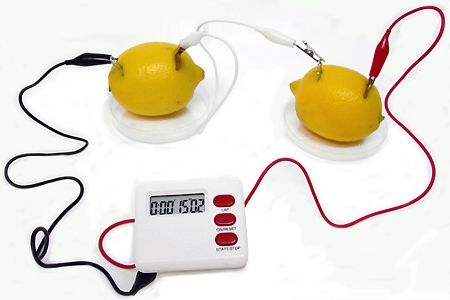If Life Hands You Lemons Make a Battery
By Mike Isley
Product Developer
Introduction
With this lab, pairs of middle or high school students work together to make a 2-cell battery using a paper clip, a penny, and a fresh lemon as each of the cells. The battery can power a digital LCD clock or timer that is normally powered by a 1.5-V button battery. The activity can be completed in 35 min or less.
Explanation
A lemon battery generates electricity (a flow of electrons) due to chemical reactions occurring at electrodes inside the lemon. The outer coating of zinc on a steel paper clip is oxidized, and the paper clip becomes a negatively charged anode. The electrons that are released flow from the zinc through a wire to a copper penny, which channels the electrons to the positive hydrogen ions, H+ in the lemon’s acidic juice. The hydrogen ions are reduced to neutral hydrogen atoms, which pair to form hydrogen gas, H2. The penny becomes a positively charged cathode as the electrons are funneled away. Both reactions are shown below, along with the net reaction.
| The paper clip, zinc electrode (anode) | Oxidation: | Zn → Zn2+ + 2e– |
| The penny, copper electrode (cathode) | Reduction: | 2H+ + 2e– → H2 |
| Net reaction: | Zn + 2H+ → Zn2+ + H2 |
One misconception that students may have is that the lemons themselves are the batteries producing the current. The lemons provide the liquid electrolyte that completes the circuit. The source of current (the electron flow) is the zinc atoms of the paper clip.
Content standards
Grades 5–8
Science as Inquiry
- Abilities necessary to do scientific inquiry
- Understandings about scientific inquiry
Physical Science
- Properties and changes of properties in matter
- Transfer of energy
Grades 9–12
Science as Inquiry
- Abilities necessary to do scientific inquiry
- Understandings about scientific inquiry
Physical Science
- Structure and properties of matter
- Chemical reactions
- Interactions of energy and matter
Safety
Use safety goggles. Take care when making slits in the lemon with a knife. Keep the lemon batteries away from any heat or flame due to the small amount of flammable hydrogen gas that may escape at the penny electrode. Acidic lemon juice may cause minor skin irritation and possibly fade clothing. Dilute any spills with water.
Materials needed per student group
- 2 Fresh Lemons
- 3 Copper Wires with Alligator Clips
- 2 Jumbo or Standard Metal Paper Clips
- 2 Pennies
- Voltmeter or Multimeter
- Digital Clock or Timer
- Knife
- Paper Towels
Procedure
1-Cell battery (1 lemon)
- Applying some pressure, roll a lemon on a table to loosen the pulp inside.
- With a knife, carefully make 2 small slits an inch or 2 apart in the lemon rind.
- In 1 slit, insert a jumbo paper clip halfway into the lemon.
- In the other, insert a penny halfway into the lemon.
- Attach the alligator clip of 1 wire to the paper clip. This is the negative electrode.
- Attach the alligator clip of another wire to the penny. This is the positive electrode.
- Check the voltage by connecting the other ends of the wires to the positive and negative probes of a voltmeter or multimeter. (If the reading is negative, reverse the connections.) Record the voltage.
2-Cell battery (2 lemons connected in series)
- Repeat steps 1–4 above with a second lemon.
- Attach the other end of the wire connected to the penny of lemon #1 to the paper clip of lemon #2. This positive-to-negative connection is called connecting in a series.
- Attach a third wire to the penny of lemon #2. This wire is positive, while the wire from the paper clip of lemon #1 is negative.
- Check the voltage of this 2-cell battery by connecting the other ends of the wires to the positive and negative probes of the voltmeter or multimeter. Record the voltage.
- Remove the button battery from a digital timer or digital clock.
- Note the 2 wire contacts in the battery holder. The center one is the negative pole, and the side contact is the positive pole. You may have to bend the center contact up and the side contact out to attach the alligator clips of the wires.
- After attaching them to the contacts, do not allow the alligator clips to touch each other.
- Turn on the timer or observe the display of your digital clock. What do you see?

Multiple cells in series
You may want to have your student groups combine their cells with those of other groups and connect 4 or more lemons in series. Or, students may cut the lemons in halves or quarters to make more cells (the voltage output for each cell will remain the same). For each additional lemon or partial lemon, add a wire connecting a penny of one (+) to the paper clip (–) of another. Four lemons in series will power a 1.7-V LED. Remind your students that the short leg of the LED is the negative pole and the long leg, the positive; the LED will illuminate only if connected properly. LEDs can be purchased from local electronics suppliers or online.
Extension activities
- Will other fruits and vegetables work as well as lemons? Try apples, oranges, kiwis, and potatoes.
- Try using other metals as electrodes.
- Does the depth of the electrode in the pulp affect the voltage?
- Does the size of the electrode affect voltage?
- Will various fruit juices produce the same voltage as the corresponding fruits?

